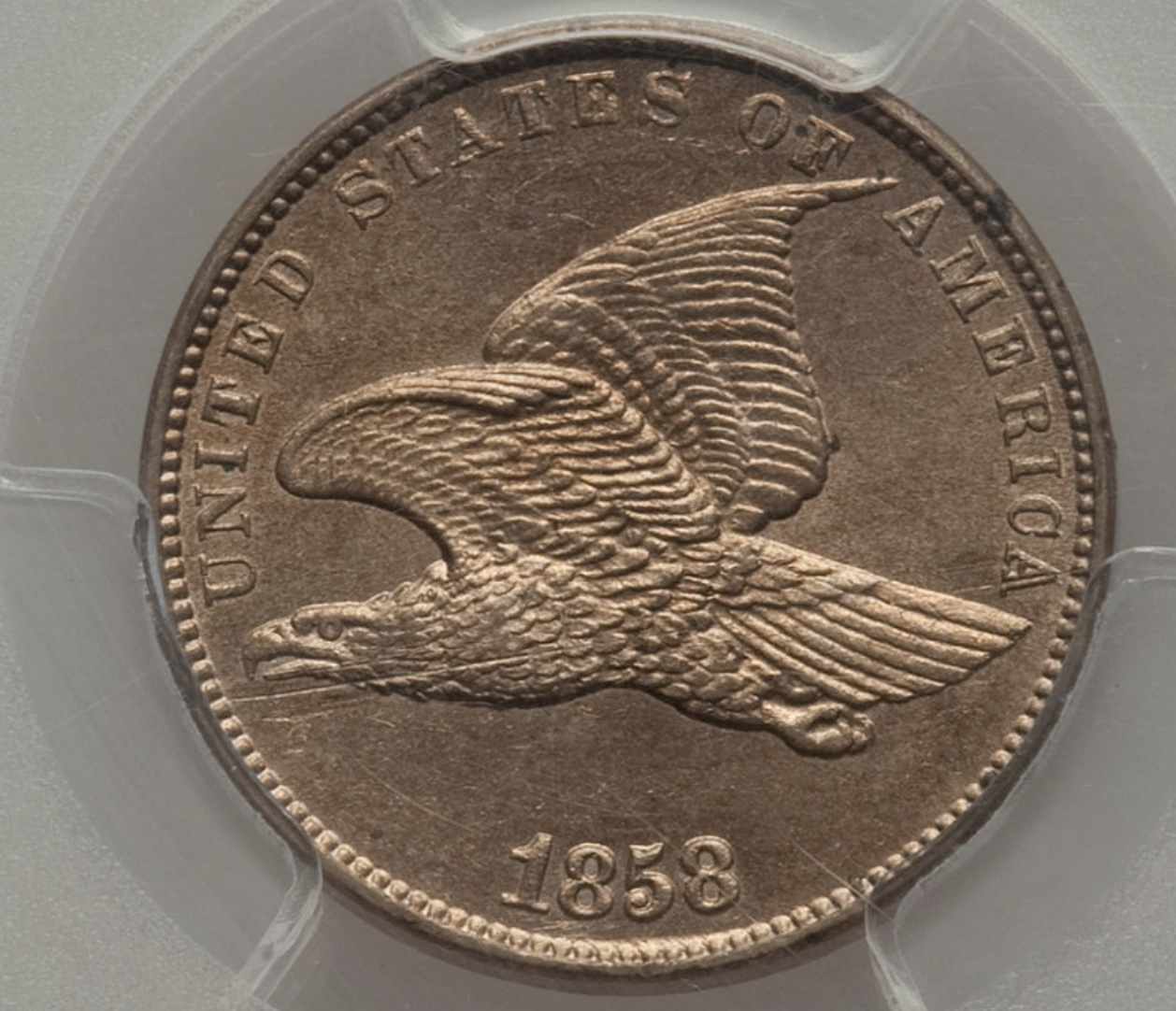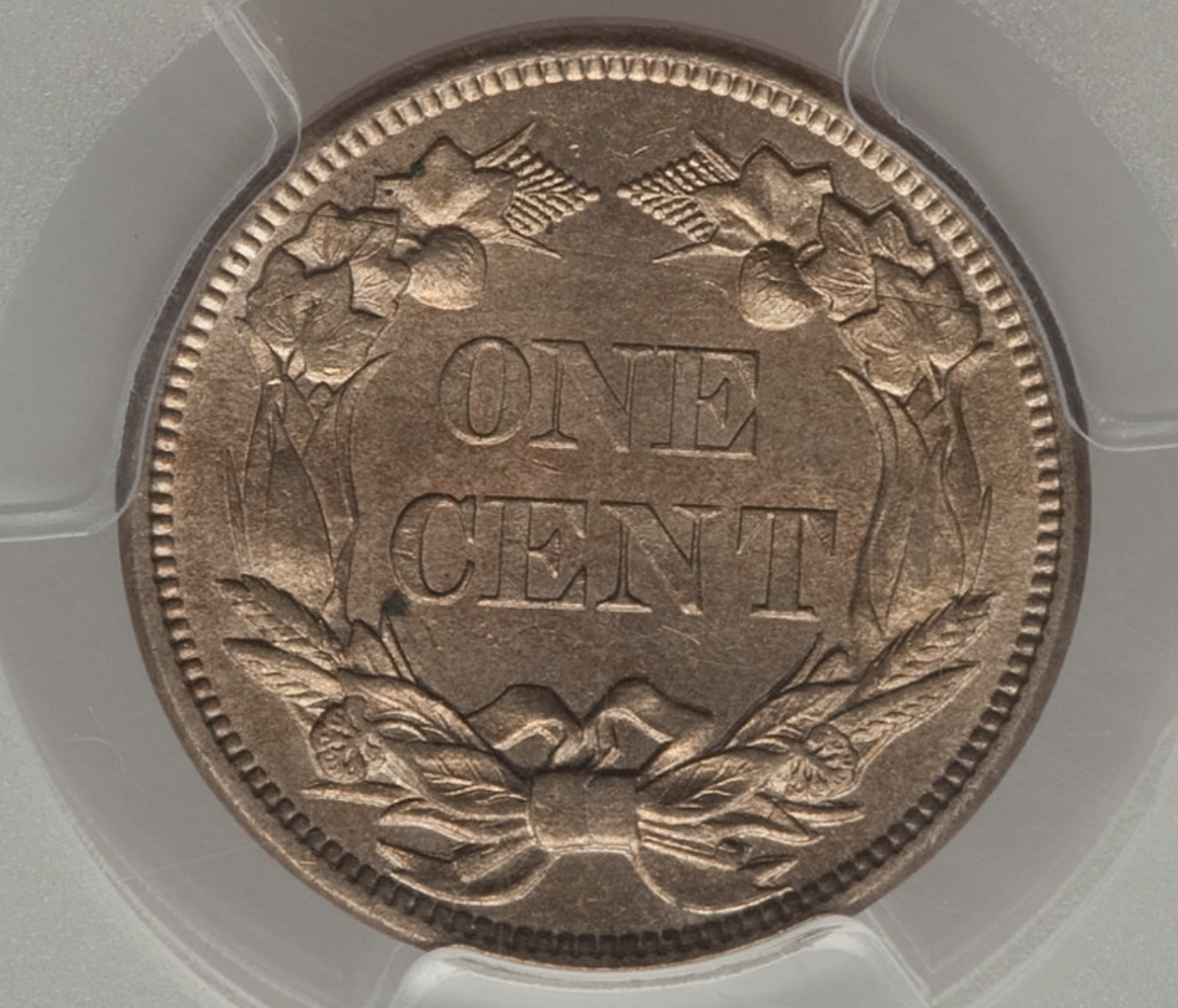Would you straight grade this Flying Eagle? **** Slab posted ****
 DMWJR
Posts: 6,089 ✭✭✭✭✭
DMWJR
Posts: 6,089 ✭✭✭✭✭
And if so, why?


Doug
2
 DMWJR
Posts: 6,089 ✭✭✭✭✭
DMWJR
Posts: 6,089 ✭✭✭✭✭
And if so, why?


Comments
Nope, that gets a scratch notation in my book. Bet it's a staple scratch too.
If I was the grader and it looked as bad in-hand (some lighting techniques over-emphasize a light scratch) it would not grade. If I was a sight-unseen buyer of this in a straight-grade holder I’d be might disappointed.
Note: It also has a line on the reverse matching the line on the obverse
No. Look closely and you will see the two lines do not match up.
Yes you are correct they are not in the same place on both sides of the coin.
I don’t think it will straight grade due to the scratch. Too bad because at first glance it is a decent looking coin.
No. I don't see that straight grading. Details scratches. Unfortunate damage to a nice coin.
No. What a shame!
No. But that's a very nice strike. Love the feathers.
Lance.
That's amazing it straight graded. If I would have sent it in it would of details holders in a heartbeat!!!
HAPPY COLLECTING
Wow...
Successful BST transactions with: SilverEagles92; Ahrensdad; Smitty; GregHansen; Lablade; Mercury10c; copperflopper; whatsup; KISHU1; scrapman1077, crispy, canadanz, smallchange, robkool, Mission16, ranshdow, ibzman350, Fallguy, Collectorcoins, SurfinxHI, jwitten, Walkerguy21D, dsessom.
You can purchase it in January at auction!
But both of them ARE in exactly the same DIRECTION.
They are NOT post-mint scratches. They are planchet marks from when the strip was rolled out.
So they were present on the coin as struck.
Whether or not this invalidates the coin for a straight grade is debatable.
I might consider a straight-grade for it, with some reduction in the final number for the defect.
The lights must have gone out in the grading room??
Yes maybe a net 60. I agree, that's why I asked the question. I know they wouldn't have graded it for me
Seems like a no-brainer "details" grade, but I suspect there is a twist here.
I would not put that in a holder. But I've seen that coin before, so I know it graded a 63.
If it walks like a scratch, talks like a scratch and looks like a scratch it is a scratch. I don't care how it got there. It is a coin I would never buy and certainly not as a 63.
I was thinking roller marks, but IMO its should be noted on holder, straight grade is ok, but needs notation.
If I bought this as a 63 sight unseen, Id be disappointed!!
Perfect example of buy the coin not the holder!
Maybe we all need to buy a ...scratch off.:)
The "scratch" is too straight and fine to be post mint, why the graders and finalizer saw it as a straight coin. God help anyone selling a coin like that raw, and thankfully the services exist as a consumer help option.
I am late to this thread... and first impression was 'no grade - details'....Now that @dcarr has given his professional opinion, I am reconsidering...I just do not understand why the 'scratch' or planchet flaw was not filled in with the strike - I would have thought it would disappear within the feathers at least... This has me puzzled. Cheers, RickO
Yeah, I've seen similar on a fair number of early coinage. There are a couple Gobrecht dollars that are even worse. Those are restrike pieces that Linderman, et al, were making out of rejected planchets. You'll also see fairly strong drawbench lines on gold and silver.
I can understand grading these, but the TPGs should note "Planchet Flaw" if for no other reason than to avoid confusing collectors. And, no, I don't think they're worth the same as a piece with a decent planchet.
I agree, except for the fact that they graded it a 63. That is where I disagree. This is what the grade of 60 is for, or the error service. It is obviously is not circulated, but it has a planchet flaw and to give it a 63 is just out of line. Anyone who pays 63 money for it will be stuck with it until the next sucker comes along.
I can see the TPG's view. It is "as made" at the mint. So, the only way they can grade it is on that basis. Like I said, the holder should have "Planchet Flaw" or "Defective Planchet." With that, a prospective buyer would then know the piece is considered to be a 63 but has a defect. The price is then up to what the buyer thinks it's worth.
Maybe they netted it down a point for the defect, the strike and luster looks above average for the grade.
Interesting thread!
My YouTube Channel
I've seen worse straight grade... At ANA for giggles I was shown a newly prong holder graded half cent with the wording inside the reverse wreath smoothly removed by tooling.
FWIW... I compare this to other pieces graded at 63. Does this one have more or less eye appeal? I then spend my money accordingly.
Successful BST transactions with: SilverEagles92; Ahrensdad; Smitty; GregHansen; Lablade; Mercury10c; copperflopper; whatsup; KISHU1; scrapman1077, crispy, canadanz, smallchange, robkool, Mission16, ranshdow, ibzman350, Fallguy, Collectorcoins, SurfinxHI, jwitten, Walkerguy21D, dsessom.
i dont think i would want that one. the scratch bothers me on but still a nice grade. jmo
I think @dcarr is probably right, but I still wouldn't want to own it, and I still wouldn't be happy if I bought it sight-unseen in a graded holder.
That scratch would be a killer for me. I am surprised they only dinged it two points for that. I have a similar one in a 65 holder sans the scratch.
Submitter was graded not so much the coin.?
It's plainly roller marks, AS MADE and not a scratch, not PMD. My goodness.
I consider such marks to be a negative. My OPINION of the coin does not change.
Why doesn't that ever happen to me?
BHNC #203
No problem with a straight grade, that is a planchet flaw, not scratch. Not the popular opinion it seems, but I think it adds some character to an otherwise bland coin.
Collector, occasional seller
My opinion of it would be negative too (I wouldn't want it as a MS63) but for all I know it had 65 surfaces, and this is how they netted it. Still, it's important to recognize the difference between a mint-made appearance, and post mint damage. This coin (and all coins) would be a poster child for realizing that despite 2, 3 or more coins that share a common TPG grade, they might not all be equally desirable.
If @dcarr is correct and those are planchet flaws, then this is a much different discussion, isn't it? I mean, they don't detail grade adjustment marks.
All comments reflect the opinion of the author, even when irrefutably accurate.
I have ALWAYS wondered about this as a possibility.
"As made" kinda trumps all of the scratch discussion. If it is, in fact, a defective planchet, the term "scratch" just doesn't apply. I'm not even sure that a gem coin, presented "as struck", should take a 2 grade level hit.
I'm glad there's no more disagree button. Flame away
Check out my current listings: https://ebay.com/sch/khunt/m.html?_ipg=200&_sop=12&_rdc=1
To me this is what 61 and 62 are for. Clearly it is an uncirculated coin with a problem even if that problem originated at the mint. It’s not in an error holder like a clipped planchet would be in.
I don't have time to read all the posts. Hopefully someone corrected all the misstatements already. The coin is as struck. The "scratch" is not PMD. While it is very detracting we don't call it a scratch. In the 70's we named these marks "Planchet Stria" from my Geology days. "Roller Marks" are basically the same thing: striations in the planchet that were not struck out. Since these marks affect eye-appeal they lower the coin's value for most collectors.
PS Some TPGS mention these on the label if they are this distracting.
How bad does the planchet flaw need to be for PCGS to assign it a ".93"?
PCGS's website says "Small, unobtrusive planchet flaws are acceptable, but large, obvious, poorly placed, or distracting flaws are rejected."
This looks about as "poorly placed" as it could be.
I could see a straight grade as an error submission.
Lance.